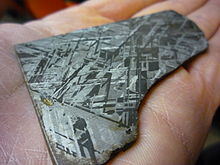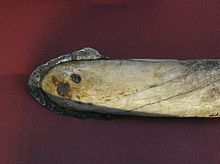Meteoric iron: Difference between revisions
Chris.urs-o (talk | contribs) added Category:Native element minerals using HotCat |
|||
| Line 79: | Line 79: | ||
Before the advent of iron [[smelting]], meteoric iron was the only source of iron metal apart from minor amounts of [[telluric iron]]. Meteoric iron was already used before the beginning of the [[iron age]] to make cultural objects, tools and weapons.<ref name="Waldbaum 1980">Waldbaum, J. C. and James D. Muhly; ''The first archaeological appearance of iron and the transition to the iron age'' chapter in ''The coming of the age of iron,'' Theodore A. Wertme. ed., Yale University Press, 1980, ISBN 978-0300024258</ref> |
Before the advent of iron [[smelting]], meteoric iron was the only source of iron metal apart from minor amounts of [[telluric iron]]. Meteoric iron was already used before the beginning of the [[iron age]] to make cultural objects, tools and weapons.<ref name="Waldbaum 1980">Waldbaum, J. C. and James D. Muhly; ''The first archaeological appearance of iron and the transition to the iron age'' chapter in ''The coming of the age of iron,'' Theodore A. Wertme. ed., Yale University Press, 1980, ISBN 978-0300024258</ref> |
||
In ancient Egypt an iron metal pearl was found in a graveyard near [[Gerzeh]] that contained 7.5% Ni.<ref name="Pre-Dynastic Iron Beads">{{cite web|title=Pre-Dynastic Iron Beads from Gerzeh, Egypt|url=http://www.ucl.ac.uk/iams/newsletter/accordion/journals/iams_19/iams_19_1995_el_gayer|publisher=ucl.ac.uk|accessdate=28 December 2012}}</ref><ref name=Rehren>{{cite journal|last=Rehren|first=Thilo|author2=Belgya, Tamás |author3=Jambon, Albert |author4=Káli, György |displayauthors=4 |author5=Kasztovszky, Zsolt |author6=Kis, Zoltán |author7=Kovács, Imre |author8=Maróti, Boglárka |author9=Martinón-Torres, Marcos |author10=Miniaci, Gianluca |author11=Pigott, Vincent C. |author12=Radivojević, Miljana |author13=Rosta, László |author14=Szentmiklósi, László |author15=Szőkefalvi-Nagy, Zoltán|title=5,000 years old Egyptian iron beads made from hammered meteoritic iron|journal=Journal of Archaeological Science|date=31 July 2013|doi=10.1016/j.jas.2013.06.002}}</ref> A dagger made from meteoric iron was found in the tomb of [[Tutankhamun]].<ref name="Bjorkman 1973">{{cite journal|last=Bjorkman|first=Judith Kingston|title=Meteors and Meteorites in the ancient Near East|journal=Meteoritics|date=1973|pages=91–132|doi=10.1111/j.1945-5100.1973.tb00146.x }}</ref> |
In ancient Egypt an iron metal pearl was found in a graveyard near [[Gerzeh]] that contained 7.5% Ni.<ref name="Pre-Dynastic Iron Beads">{{cite web|title=Pre-Dynastic Iron Beads from Gerzeh, Egypt|url=http://www.ucl.ac.uk/iams/newsletter/accordion/journals/iams_19/iams_19_1995_el_gayer|publisher=ucl.ac.uk|accessdate=28 December 2012}}</ref><ref name=Rehren>{{cite journal|last=Rehren|first=Thilo|author2=Belgya, Tamás |author3=Jambon, Albert |author4=Káli, György |displayauthors=4 |author5=Kasztovszky, Zsolt |author6=Kis, Zoltán |author7=Kovács, Imre |author8=Maróti, Boglárka |author9=Martinón-Torres, Marcos |author10=Miniaci, Gianluca |author11=Pigott, Vincent C. |author12=Radivojević, Miljana |author13=Rosta, László |author14=Szentmiklósi, László |author15=Szőkefalvi-Nagy, Zoltán|title=5,000 years old Egyptian iron beads made from hammered meteoritic iron|journal=Journal of Archaeological Science|date=31 July 2013|doi=10.1016/j.jas.2013.06.002}}</ref> A dagger made from meteoric iron was found in the tomb of [[Tutankhamun]].<ref name="Bjorkman 1973">{{cite journal|last=Bjorkman|first=Judith Kingston|title=Meteors and Meteorites in the ancient Near East|journal=Meteoritics|date=1973|pages=91–132|doi=10.1111/j.1945-5100.1973.tb00146.x }}</ref><ref>{{cite journal|author1=Daniela Comelli, Massimo D'orazio, Luigi Folco, Mahmud El-Halwagy, Tommaso Frizzi, Roberto Alberti, Valentina Capogrosso, Abdelrazek Elnaggar, Hala Hassan, Austin Nevin, Franco Porcelli, Mohamed G. Rashed and Gianluca Valentini |title=The meteoritic origin of Tutankhamun's iron dagger blade|journal=Meteoritics & Planetary Science|date=2016|volume=(Early View)|pages=(Early View)|doi=10.1111/maps.12664|url=http://onlinelibrary.wiley.com/doi/10.1111/maps.12664/full}}</ref> |
||
The [[Inuit]] used parts of the [[Cape York meteorite]].<ref>''Iron and steel in ancient times'' by Vagn Fabritius Buchwald - Det Kongelige Danske Videnskabernes Selskab 2005</ref><ref>{{cite journal|author =T. A. Rickard| title = The Use of Meteoric Iron| journal =Journal of the Royal Anthropological Institute|volume = 71|issue = 1/2|date = 1941|pages = 55–66|doi = 10.2307/2844401|jstor =2844401|publisher =Royal Anthropological Institute of Great Britain and Ireland}}</ref><ref>{{cite journal|author = Buchwald, V. F. |
The [[Inuit]] used parts of the [[Cape York meteorite]].<ref>''Iron and steel in ancient times'' by Vagn Fabritius Buchwald - Det Kongelige Danske Videnskabernes Selskab 2005</ref><ref>{{cite journal|author =T. A. Rickard| title = The Use of Meteoric Iron| journal =Journal of the Royal Anthropological Institute|volume = 71|issue = 1/2|date = 1941|pages = 55–66|doi = 10.2307/2844401|jstor =2844401|publisher =Royal Anthropological Institute of Great Britain and Ireland}}</ref><ref>{{cite journal|author = Buchwald, V. F. |
||
Revision as of 18:26, 2 June 2016
| Meteoric Iron (native iron) | |
|---|---|
 Widmanstätten pattern showing the two forms of nickel–iron minerals, kamacite and taenite | |
| General | |
| Category | Native element mineral |
| Formula (repeating unit) | Fe and Ni in different ratios |
| Space group | Different structures |
| Identification | |
| Luster | Metallic |
| Diaphaneity | Opaque |
Meteoric iron, sometimes meteoritic iron,[1] is a native metal found in meteorites and made from the elements iron and nickel mainly in the form of the mineral phases kamacite and taenite. Meteoric iron makes up the bulk of iron meteorites but is also found in other meteorites. Apart from minor amounts of telluric iron, meteoric iron is the only naturally occurring native metal of the element iron on the Earth's surface.
Mineralogy
The bulk of meteoric iron consists of taenite and kamacite. Taenite is a face centered cubic and kamacite a body centered cubic iron-nickel-alloy.
Meteoric iron can be distinguished from telluric iron chemically. Telluric iron has lower nickel and higher carbon contents.[citation needed]
Trace amounts of gallium and germanium in meteoric iron can be used to distinguish different meteorite types. The meteoric iron in stony iron meteorites is identical to the "gallium-germanium group" of the iron meteorites.[2]
| Mineral | Formula | Nickel (Mass-% Ni) | Crystal structure | Notes & References |
|---|---|---|---|---|
| Antitaenite | γLow Spin-(Ni,Fe) | 20-40 | face centered cubic | Only approved as a variety of taenite by the IMA |
| Kamacite | α-(Fe,Ni); Fe0+0.9Ni0.1 | 5-10 | body centered cubic | Same structure as ferrite |
| Taenite | γ-(Ni,Fe) | 20-65 | face centered cubic | Same structure as austenite |
| Tetrataenite | (FeNi) | 48-57 | tetragonal | [3] |
Structures
Meteoric iron forms a few different structures that can be seen by etching or in thin sections of meteorites. The Widmanstätten pattern forms when meteoric iron cools and kamacite is exsolved from taenite in the form of lamellas.[4] Plessite is a more fine-grained intergrowth of the two minerals in between the lamella of the Widmanstätten pattern.[5] Neumann lines are fine lines running through kamacite crystals that form through impact-related deformation.[6]
Cultural and historical usage

Before the advent of iron smelting, meteoric iron was the only source of iron metal apart from minor amounts of telluric iron. Meteoric iron was already used before the beginning of the iron age to make cultural objects, tools and weapons.[7]
In ancient Egypt an iron metal pearl was found in a graveyard near Gerzeh that contained 7.5% Ni.[8][9] A dagger made from meteoric iron was found in the tomb of Tutankhamun.[10][11]
The Inuit used parts of the Cape York meteorite.[12][13][14]
Fragments from Gibeon were used for centuries by the Nama people. There are also reports of their use for manufacture of various items in Tibet (see Thokcha), including the Iron Man, a statue of Vaiśravaṇa carved from an iron meteorite.[15] In 1000 CE, a Tibetan Buddhist statue, the Iron Man, was likely carved from an ataxite meteorite. It might even be made from a fragment of the Chinga meteorite.[16][17]
Even after the invention of smelting, meteoric iron was sometimes used where this technology was not available or metal was scarce. A piece of the Cranbourne meteorite was made into a horseshoe around 1854.[18]
Today meteoritic iron is used in niche jewellery and knife production, but most of it is used for research, educational or collecting purposes.
Atmospheric phenomena
Meteoric iron also has an effect on the Earth's atmosphere. When meteorites descend through the atmosphere outer parts are ablated. Meteoric ablation is the source of many elements in the upper atmosphere. When meteoric iron is ablated it forms a free iron atom, that can react with ozone (O3) to form FeO. This FeO may be the source of the orange bands in the spectrum of the upper atmosphere.[19]
See also
References
- ^ Rehren T, et al., "5,000 years old Egyptian iron beads made from hammered meteoritic iron", Journal of Archaeological Science 2013 text
- ^ Lovering, John F.; Nichiporuk, Walter; Chodos, Arthur; Brown, Harrison (31 December 1956). "The distribution of gallium, germanium, cobalt, chromium, and copper in iron and stony-iron meteorites in relation to nickel content and structure". Geochimica et Cosmochimica Acta. 11 (4): 263–278. doi:10.1016/0016-7037(57)90099-6.
- ^ Clarke, Roy S.; Edward R. D. Scott (1980). "Tetrataenite - ordered FeNi, a new mineral in meteorites" (PDF). American Mineralogist. 65: 624–630. Retrieved 13 December 2012.
- ^ Yang, J.; J. I. Goldstein (2005). "The formation of the Widmanstätten structure in meteorites". Meteoritics & Planetary Science. 40 (2). doi:10.1111/j.1945-5100.2005.tb00378.x.
- ^ Goldstein, J. I.; J. R. Michael (2006). "The formation of plessite in meteoritic metal". Meteorics & Planetary Science. 41 (4): 553–570. doi:10.1111/j.1945-5100.2006.tb00482.x.
- ^ Rosenhain, Walter; Jean McMinn (1925). "The Plastic Deformation of Iron and the Formation of Neumann Lines". Proceedings of the Royal Society. 108: 231–239. doi:10.1098/rspa.1925.0071.
- ^ Waldbaum, J. C. and James D. Muhly; The first archaeological appearance of iron and the transition to the iron age chapter in The coming of the age of iron, Theodore A. Wertme. ed., Yale University Press, 1980, ISBN 978-0300024258
- ^ "Pre-Dynastic Iron Beads from Gerzeh, Egypt". ucl.ac.uk. Retrieved 28 December 2012.
- ^ Rehren, Thilo; Belgya, Tamás; Jambon, Albert; Káli, György; Kasztovszky, Zsolt; Kis, Zoltán; Kovács, Imre; Maróti, Boglárka; Martinón-Torres, Marcos; Miniaci, Gianluca; Pigott, Vincent C.; Radivojević, Miljana; Rosta, László; Szentmiklósi, László; Szőkefalvi-Nagy, Zoltán (31 July 2013). "5,000 years old Egyptian iron beads made from hammered meteoritic iron". Journal of Archaeological Science. doi:10.1016/j.jas.2013.06.002.
{{cite journal}}: Unknown parameter|displayauthors=ignored (|display-authors=suggested) (help) - ^ Bjorkman, Judith Kingston (1973). "Meteors and Meteorites in the ancient Near East". Meteoritics: 91–132. doi:10.1111/j.1945-5100.1973.tb00146.x.
- ^ Daniela Comelli, Massimo D'orazio, Luigi Folco, Mahmud El-Halwagy, Tommaso Frizzi, Roberto Alberti, Valentina Capogrosso, Abdelrazek Elnaggar, Hala Hassan, Austin Nevin, Franco Porcelli, Mohamed G. Rashed and Gianluca Valentini (2016). "The meteoritic origin of Tutankhamun's iron dagger blade". Meteoritics & Planetary Science. (Early View): (Early View). doi:10.1111/maps.12664.
{{cite journal}}: CS1 maint: multiple names: authors list (link) - ^ Iron and steel in ancient times by Vagn Fabritius Buchwald - Det Kongelige Danske Videnskabernes Selskab 2005
- ^ T. A. Rickard (1941). "The Use of Meteoric Iron". Journal of the Royal Anthropological Institute. 71 (1/2). Royal Anthropological Institute of Great Britain and Ireland: 55–66. doi:10.2307/2844401. JSTOR 2844401.
- ^ Buchwald, V. F. (1992). "On the Use of Iron by the Eskimos in Greenland". Materials Characterization. 29 (2): 139–176. doi:10.1016/1044-5803(92)90112-U. JSTOR 2844401.
- ^ Der Lama mit der Hose: „Buddha from space“ ist offenbar eine Fälschung (Telepolis 13.10.2012)
- ^ "Ancient Buddhist Statue Made of Meteorite, New Study Reveals". Science Daily. Retrieved 26 December 2012.
- ^ Buchner, Elmar; Schmieder, Martin; Kurat, Gero; Brandstätter, Franz; Kramar, Utz; Ntaflos, Theo; Kröchert, Jörg (1 September 2012). "Buddha from space-An ancient object of art made of a Chinga iron meteorite fragment*". Meteoritics & Planetary Science. 47 (9): 1491–1501. doi:10.1111/j.1945-5100.2012.01409.x.
{{cite journal}}: Unknown parameter|displayauthors=ignored (|display-authors=suggested) (help) - ^ "The Cranbourne Meteorites" (PDF). City of Casey. Retrieved 29 December 2012.
- ^ Evans, W. F. J.; Gattinger, R. L.; Slanger, T. G.; Saran, D. V.; Degenstein, D. A.; Llewellyn, E. J. (20 November 2010). "Discovery of the FeO orange bands in the terrestrial night airglow spectrum obtained with OSIRIS on the Odin spacecraft". Geophysical Research Letters. 37 (22). doi:10.1029/2010GL045310.
{{cite journal}}: Unknown parameter|displayauthors=ignored (|display-authors=suggested) (help)
